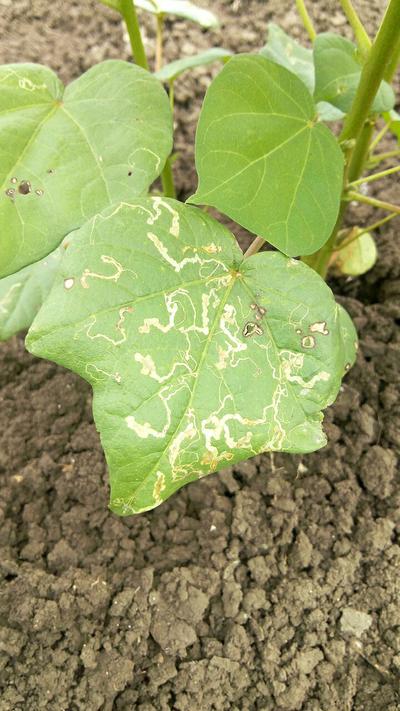Cotton Leaf Perforator
Bucculatrix thurberiella
Insect
In a Nutshell
- Young caterpillars mine the leaves on the inside, creating white or gray, serpentine tunnels.
- As they grow larger, they exit these mines and chew out parts of the lower or upper epidermis, resulting in window panes.
- Heavily infested leaves may be reduced to a network of veins.
Can also be found in
Symptoms
Most damage occurs in the top third of plants. The youngest caterpillars mine the leaves on the inside, creating white or gray, tiny, serpentine tunnels. As they grow larger, they exit these mines and stay on the surface of the leaf blades, chewing out parts of the lower or upper epidermis. This results in light brown window panes on the leaves that sometimes dry up and drop, leaving and irregular hole. In severe cases, the defoliation of the plants may cause bolls to open prematurely, or the shedding of squares and small bolls.
Recommendations

Organic Control
Predators, such as the nymphs of some species of Orius, some larvae of Chrysopa and adults of Collops and Hippodamia were observed feeding on the larvae of B. thurberiella in the field. In laboratory conditions, other predators such as adults of the genera Geocoris, Sinea, and Zelus, and adults and nymphs of the genus Nobis were observed feeding on cotton leaf perforator larvae. It is important to limit the use of broad-scale insecticides to maintain the populations of these beneficial insects. Srays of spinosad are also acceptable for use on organically grown cotton.

Chemical Control
Always consider an integrated approach with preventive measures together with biological treatments if available. Many insecticide formulations can be used against the cotton leaf perforator, and treatment should target later stage larvae, as the young stages are protected inside the leaves. Some examples of active ingredients are: malathion, dimethoate and a mixture of different ingredients.
What caused it?
The symptoms are caused by the the larvae of the cotton leaf perforator, Bucculatrix thurberiella. Moths have a wingspan of about 7-9 mm. Forewings are white, but the margin from the base of the wing to beyond the middle is blackish. The hindwings are pale whitish. The larvae feed on leaves of cotton and some wild relatives, for example Thurberia thespesioides. Young larvae are flattened, yellow to orange caterpillars that bore into leaves and tunnel between leaf surfaces. Older larvae exit the inner tissues and start feeding on either the upper or the under surface. When the feeding activities of this stage are finished the larva weaves a tiny circular silk shelter over some slight depression on the underside of the leaf. In severe infestations, leaves may be skeletonized and defoliation take place.
Preventive Measures
- Use pheromone traps to monitor populations.
- Monitor fields for the presence of larvae on the surface of top leaves.
- Make sure to make a reasonable use of insecticides, as these can affect beneficial insects.
- Harvest early to avoid peak populations.
- Plow the fields after harvest to help reduce overwintering populations.



